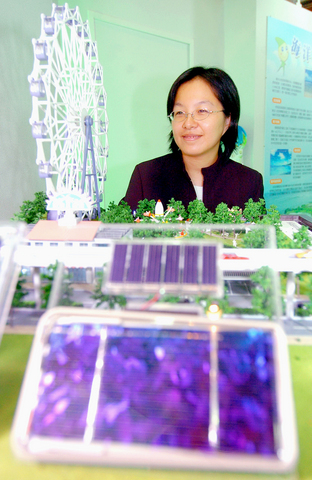Taiwan should make a comprehensive energy policy and implement measures to cut greenhouse emissions to comply with the Kyoto Protocol that took effect on Feb. 16 this year, officials and energy experts said yesterday.
"The energy and climate policies made in 1998 did not help reduce emissions of carbon dioxide, or greenhouse emissions, meaning the policies need to be overhauled," Lee Chien-ming (李堅明), associate professor at National Taipei University's Institute of Natural Resource Management, said at the National Energy Conference in Taipei yesterday.
The two-day conference is being held to examine and modify Taiwan's energy policies in different sectors to reduce greenhouse gas emissions after the Kyoto Protocol went into effect.

PHOTO: LIAO CHENG-HUI, TAIPEI TIMES
Under the protocol, industrialized countries agreed to reduce emissions by an average 5.2 percent from 1990 levels by 2012.
Though not a signatory of the global agreement because it is not a member of the UN, Taiwan has pledged to keep in line with the international trend toward environmental protection since 1998, one year after the Kyoto Protocol was proposed.
In that same year, the government held a national energy meeting and came up with policies to keep carbon dioxide emissions at the 2000 level by 2020, and enhance efficiency in energy productivity by 28 percent.
Those efforts, however, did not achieve the goals, as energy consumption rose by 28 percent from 1998 to 2003, and carbon dioxide emissions also increased 26 percent to 255.98 million tonnes in 2003, Lee said, citing statistics from the Bureau of Energy under the Ministry of Economic Affairs.
Ho Shun-chin (
She said Taiwan relies heavily on fossil-fuel energy, which accounts for about 90.6 percent of all energy supplies. Coal, which produces the most carbon dioxide, increased from 17.5 percent of consumed fossil fuels in 1983, to 32.5 percent in 2003 -- a more rapid increase than other fuels, such as oil and natural gas, she added.
To deal with the situation, both Lee and Ho urged the government to initiate a bill to regulate greenhouse gas emissions and set out effective measures and tools to carry out the policies.
One suggestion is to adjust electricity prices to reflect fluctuating energy prices, Ho said.
"Industrial users, in particular, consume the majority of electricity, but pay one-third to one-half of the fees that household users pay," she said.
Another measure is adding a fuel surcharge to retail gasoline prices, in a bid to discourage usage of gasoline while helping cut emissions from autos and motorcycles, Lee said, adding that this policy was first proposed during the 1998 meeting, but was not implemented.
Development and promotion of renewable energy is another solution, said Arnold Baker, president of International Association for Energy Economics.
Baker addressed at the conference yesterday as a guest speaker. He said that hydrogen, for example, has been widely used by governments and car companies as a major renewable energy source and atlernative to solar, wind and geothermal energy.
In addition, nanotechnology has the potential to fundamentally change energy supply and demand, as several innovations from applications of the technology have been shown to improve power efficiency, he added.
Admitting that the government has a lot of work to do, Vice Premier Wu Rong-i (吳榮義) said energy policies should be made in such a way as to decouple economic growth and environmental contamination, as many advanced countries already maintain high GDP growth rates without producing more emissions.
The energy conference will continue today at the Taipei International Convention Center. The focus will be on possible impacts the protocol will have on various sectors and related responses.

Taiwan’s rapidly aging population is fueling a sharp increase in homes occupied solely by elderly people, a trend that is reshaping the nation’s housing market and social fabric, real-estate brokers said yesterday. About 850,000 residences were occupied by elderly people in the first quarter, including 655,000 that housed only one resident, the Ministry of the Interior said. The figures have nearly doubled from a decade earlier, Great Home Realty Co (大家房屋) said, as people aged 65 and older now make up 20.8 percent of the population. “The so-called silver tsunami represents more than just a demographic shift — it could fundamentally redefine the

Businesses across the global semiconductor supply chain are bracing themselves for disruptions from an escalating trade war, after China imposed curbs on rare earth mineral exports and the US responded with additional tariffs and restrictions on software sales to the Asian nation. China’s restrictions, the most targeted move yet to limit supplies of rare earth materials, represent the first major attempt by Beijing to exercise long-arm jurisdiction over foreign companies to target the semiconductor industry, threatening to stall the chips powering the artificial intelligence (AI) boom. They prompted US President Donald Trump on Friday to announce that he would impose an additional

China Airlines Ltd (CAL, 中華航空) said it expects peak season effects in the fourth quarter to continue to boost demand for passenger flights and cargo services, after reporting its second-highest-ever September sales on Monday. The carrier said it posted NT$15.88 billion (US$517 million) in consolidated sales last month, trailing only September last year’s NT$16.01 billion. Last month, CAL generated NT$8.77 billion from its passenger flights and NT$5.37 billion from cargo services, it said. In the first nine months of this year, the carrier posted NT$154.93 billion in cumulative sales, up 2.62 percent from a year earlier, marking the second-highest level for the January-September

Asian e-commerce giant Shein’s (希音) decision to set up shop in a historic Parisian department store has ruffled feathers in the fashion capital. Anger has been boiling since Shein announced last week that it would open its first permanent physical store next month at BHV Marais, an iconic building that has stood across from Paris City Hall since 1856. The move prompted some French brands to announce they would leave BHV Marais, but the department store had already been losing tenants over late payments. Aime cosmetics line cofounder Mathilde Lacombe, whose brand was among those that decided to leave following